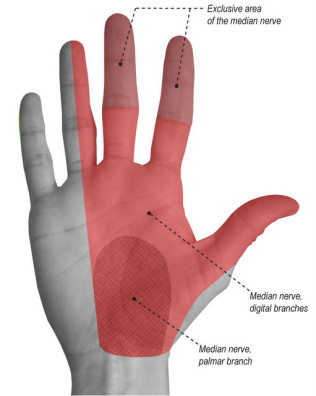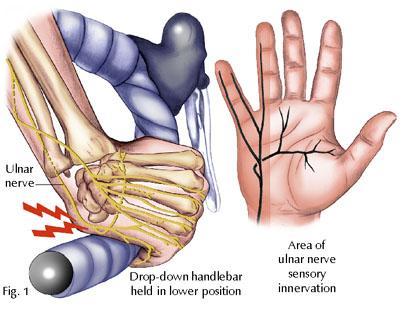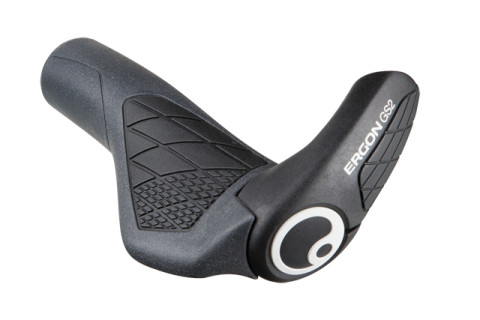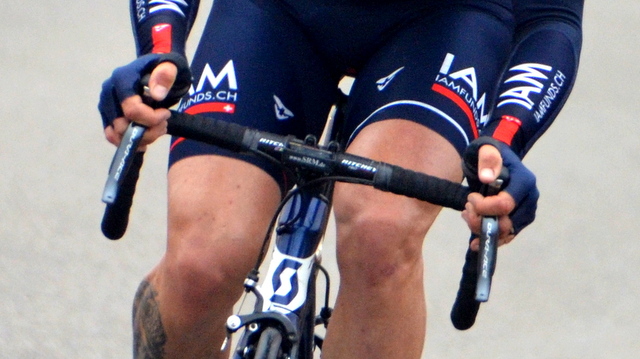Bike fit specialists Kinetic Bike Fitting operate out of Melbourne Osteopathy Sports Injury Centre’s versatile studio space. Ross Hamilton from Kinetic Bike Fitting offers some advice on one of the most common cycling conditions – Numb Hands.
Most cyclists are familiar with the feeling of numb hands from a long ride. ‘Handlebar Palsy’ is one of the most common conditions that patients mention when they get fitted to their bike. Sadly, many patients treat hand numbness as if it is just as much a part of the cycling experience as the sense of freedom you experience while gliding along the road on a summer’s day.
It is my firm opinion that a cyclist who is properly fitted to their bike and with no underlying injuries should be able to complete a 200km ride with only their legs suffering. There are two structures that are commonly responsible for causing hand numbness and they present in a distinct pattern. The ulnar nerve and the median nerve both provide cutaneous nerve supply to the palmar surface of the hand. The ulnar nerve is responsible for the lateral section (that’s the little finger and half of the ring finger). The median nerve innervates the thumb, index finger and big finger.

Both nerves pass in to the hand through tight anatomical tunnels in the wrist. The ulnar nerve passes through a structure called the Tunnel of Guyonand the median nerve passes through the Carpal Tunnel. Both the tunnel of Guyon and the Carpal Tunnel are susceptible to being crushed by weight being placed downwards on the hands while cycling.
The Tunnel of Guyon is usually the main suspect when it comes to numb hands. That’s because it is directly underneath the weight bearing section of the hand on road bike handlebars. Additionally, when using flat handlebars, many riders end up cocking their wrist inwards in a movement called radial deviation. This causes more pressure to be applied to the lateral part of the hand and consequently the Tunnel of Guyon and the ulnar nerve.

The median nerve can be put under excessive pressure when the hands are cocked back and with a rider’s weight placed upon them. This problem is exacerbated when the rider is poorly set up on their bike and has an excessive reach forwards to the handlebars. Weight placed down on the Carpal Tunnel places excessive pressure on the median nerve and the reach forwards to the handlebar also contributes to the extended wrists, therefore stretching the nerve.
A good giveaway that an injury is fit-related is that the rider only experiences the discomfort while cycling. Please keep in mind that there are many other reasons why hand numbness can occur. If you experience such numbness outside of cycling, it is likely the problem is more complex than being just related to bike fit.
SOLUTIONS
Humans are complex creatures, therefore the solution to hand numbness on the bike can be quite complex too. However the two most common solutions are enhancing the padding on the handlebars and addressing the reach to the bars when getting a bike fit. Changes in padding on a road bike can be addressed with some gel padding inserts or a double layer of handlebar tape. On a flat bar bike, ergonomic grips with bar ends are a great solution. The ergo grips spread the load of the hand over a greater surface area and bar ends give you another place to leave your hands to avoid ongoing pressure in one area.
Ergon make some excellent grips and bar ends that can save your wrists. Many other brands now produce a similar ergo-grip.

Addressing problems of hand numbness is very important. Nerves are delicate structures and spending too much time aggravating them can result in some long term damage. For example, I once borrowed somebody else’s bike to ride a 350km Audax mountain bike event. After 20-hours of jarring on an incorrectly fitted handlebar and I had a strange tingling feeling in my hands. It took six months for that tingling to dissipate. I have heard many similar stories from people riding long events such as the Tour Divide that spans the length of the Continental Divide in the United States.
Whether or not long term damage is likely, you shouldn’t have to put up with discomfort in your hands on the bike.
Kinetic Bike Fitting is operated by Dr Ross Hamilton and Craig Lia. Between them, they have over 15 years experience working in the bicycle industry. Ross is a registered Osteopath and Craig is completing his Masters of Osteopathy. Combining their knowledge as bike mechanics with the in-depth anatomy and biomechanics training of Osteopathy was a natural fit.
Ross races regularly on both the road and track and Craig races regularly in sprint and Olympic distance triathlons. To find out more, or to book a bike fit, please visit their website:

